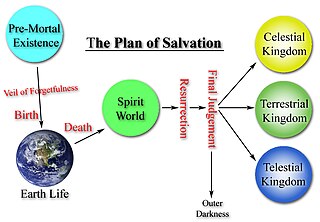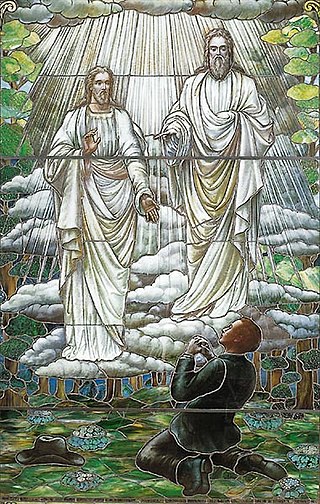See also
- Divine providence, God's intervention in the Universe
- The Promise: God's Purpose and Plan for When Life Hurts , a Catholic self-help book
God's Plan may refer to:

Irenaeus was a Greek bishop noted for his role in guiding and expanding Christian communities in the southern regions of present-day France and, more widely, for the development of Christian theology by combating heterodox or Gnostic interpretations of Scripture as heresy and defining proto-orthodoxy. Originating from Smyrna, he had seen and heard the preaching of Polycarp, who in turn was said to have heard John the Evangelist, and thus was the last-known living connection with the Apostles.

Predestination, in theology, is the doctrine that all events have been willed by God, usually with reference to the eventual fate of the individual soul. Explanations of predestination often seek to address the paradox of free will, whereby God's omniscience seems incompatible with human free will. In this usage, predestination can be regarded as a form of religious determinism; and usually predeterminism, also known as theological determinism.
Salvation is the state of being saved or protected from harm or a dire situation. In religion and theology, salvation generally refers to the deliverance of the soul from sin and its consequences. The academic study of salvation is called soteriology.

Perseverance of the saints is a Christian teaching that asserts that once a person is truly "born of God" or "regenerated" by the indwelling of the Holy Spirit, they will continue doing good works and believing in God until the end of their life.
The Adam–God doctrine was a theological idea taught in mid-19th century Mormonism by Brigham Young, a president of the Church of Jesus Christ of Latter-day Saints. Although the doctrine is rejected by the LDS Church today, it is still an accepted part of the modern theology of some Mormon fundamentalists.
The King Follett discourse, or King Follett sermon, was an address delivered in Nauvoo, Illinois, by Joseph Smith, president and founder of the Latter Day Saint movement, on April 7, 1844, less than three months before he was killed by a mob. The discourse was presented to a congregation of about twenty thousand Latter Day Saints at a general conference held shortly after the funeral service of Elder King Follett, who had died on March 9, 1844, of accidental injuries. The sermon is notable for its assertion that God was once a mortal man, and that mortal men and women can become gods through salvation and exaltation. These topics were, and are, controversial, and have received varying opinions and interpretations of what Smith meant. Literary critic Harold Bloom called the sermon "one of the truly remarkable sermons ever preached in America."

In Christianity, salvation is the saving of human beings from sin and its consequences—which include death and separation from God—by Christ's death and resurrection, and the justification entailed by this salvation.

Pain of Salvation is a Swedish progressive metal band led by Daniel Gildenlöw, who is the band's main songwriter, lyricist, guitarist, and vocalist. Pain of Salvation's sound is characterised by riff-oriented guitar work, a broad vocal range, oscillation between heavy and calm passages, complex vocal harmonies and the structures of their albums, syncopation, and polyrhythms. Thus far, every album released by the band has been a concept album. Lyrically, the band tends to address contemporary issues, such as sexuality, war, the environment, and the nature of God, humanity, and existence.

BE is the fifth studio album by Swedish band Pain of Salvation, released via InsideOutMusic in September 2004. It is a concept album focusing on the existence of God and humankind. Along with the band it features a nine-part orchestra, The Orchestra of Eternity, which features prominently throughout the album. It is the last album to feature Kristoffer Gildenlöw on bass and is the first Pain of Salvation album to be divided into more than three chapters.
Solus Christus or In Christo solo is one of the five solae that summarize the Protestant Reformers' basic belief that salvation is by faith in Christ alone.

According to the doctrine of the Church of Jesus Christ of Latter-day Saints, the largest denomination in the Latter Day Saint movement, the plan of salvation is a plan God created to save, redeem, and exalt humankind, through the atonement of Jesus Christ. The elements of this plan are drawn from various sources, including the Bible, Book of Mormon, Doctrine & Covenants, Pearl of Great Price, and numerous statements made by the leadership of the Church of Jesus Christ of Latter-day Saints. The first appearance of the graphical representation of the plan of salvation was provided in the 1952 missionary manual entitled A Systematic Program for Teaching the Gospel.

In Christian theology, the doctrine of incarnation teaches that the pre-existent divine person of Jesus Christ, God the Son, the second person of the Trinity, and the eternally begotten Logos, took upon human nature and "was made flesh" by being conceived in the womb of a woman, the Virgin Mary, also known as the Theotokos. The doctrine of the incarnation then entails that Jesus was at the same time both fully God and fully human.
The fate of the unlearned, also known as the destiny of the unevangelized, is an eschatological question about the ultimate destiny of people who have not been exposed to a particular theology or doctrine and thus have no opportunity to embrace it. The question is whether those who never hear of requirements issued through divine revelations will be punished for failure to abide by those requirements.

In the New Testament of the Christian Bible, the Book of Revelation describes a war in heaven between angels led by the Archangel Michael against those led by "the dragon", identified as the devil or Satan, who was defeated and thrown down to the earth. Revelation's war in Heaven is related to the idea of fallen angels, and possible parallels have been proposed in the Hebrew Bible and the Dead Sea Scrolls.

Mormon cosmology is the description of the history, evolution, and destiny of the physical and metaphysical universe according to Mormonism, which includes the doctrines taught by leaders and theologians of the Church of Jesus Christ of Latter-day Saints, Mormon fundamentalism, the Restoration Church of Jesus Christ, and other Brighamite denominations within the Latter Day Saint movement. Mormon cosmology draws from Biblical cosmology, but has many unique elements provided by movement founder Joseph Smith. These views are not generally shared by adherents of other Latter Day Saint movement denominations who do not self-identify as "Mormons", such as the Community of Christ.
The Dismissal is the final blessing said by a Christian priest or minister at the end of a religious service. In liturgical churches the dismissal will often take the form of ritualized words and gestures, such as raising the minister's hands over the congregation, or blessing with the sign of the cross. The use of a final blessing at the end of a liturgical service may be based upon the Priestly Blessing prescribed for the kohanim in the Torah.

The Church of Jesus Christ of Latter-day Saints focuses its doctrine and teaching on Jesus Christ; that he was the Son of God, born of Mary, lived a perfect life, performed miracles, bled from every pore in the Garden of Gethsemane, died on the cross, rose on the third day, appeared again to his disciples, and now resides, authoritatively, on the right hand side of God. In brief, some beliefs are in common with Catholics, Orthodox and Protestant traditions. However, teachings of the LDS Church differ significantly in other ways and encompass a broad set of doctrines, so that the above-mentioned denominations usually place the LDS Church outside the bounds of orthodox Christian teaching as summarized in the Nicene Creed.
The will of God or divine will is a concept found in the Hebrew Bible, the New Testament, and the Quran, according to which God's will is the cause of everything that exists.

Christian universalism was a theology prevalent in the early United States coinciding with the founding of the Latter Day Saint movement in 1830. Universalists believed that God would save all of humanity. Universalism peaked in popularity during the 1820s and 1830s, and the idea of universal salvation for all humanity was hotly debated. Several revelations of the founder of the Latter Day Saint movement, Joseph Smith, dealt with issues regarding Universalism, and it was a prominent heresy in the Book of Mormon. Smith's father was a Universalist, while his mother was a traditional Calvinist, creating strain in the Smith family home.

Death in 19th-century Mormonism involved several unique religious rituals, cultural customs, and eschatological beliefs. In the years of the Church of Christ and, later, in the Church of Jesus Christ of Latter-day Saints, death played a prominent role in the lives of members due to various diseases, forced removal from settlements, the harsh nature of life on the American frontier, and the lack of medical knowledge at the time. Mormon mortality rates climbed through most of the century until a permanent settlement in Utah Territory was established and advances in medical science were made. Before these improvements, the commonality of death in Latter-day Saint communities produced a distinct culture surrounding the death of a member of the community. The dying were either blessed to be healed or to be received into heaven, depending on the person's wishes. A phenomenon known as the "beautiful death" set forth traditions such as family and friends gathering around a person's deathbed to witness their transition into the next life. Nineteenth-century Latter-day Saints came to terms with the frequent deaths of loved ones – especially those of infants and children – by turning to the teachings offered by their religion.